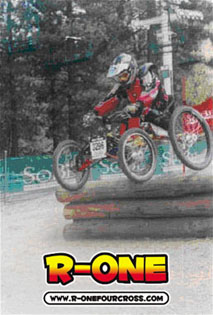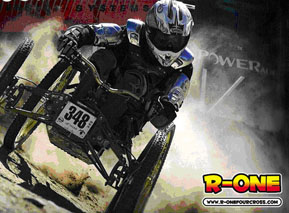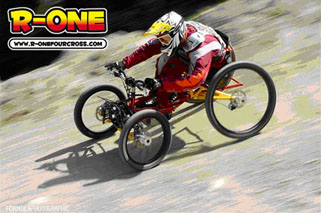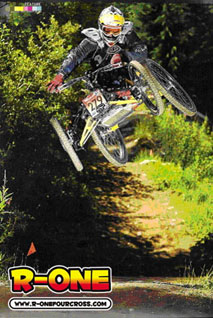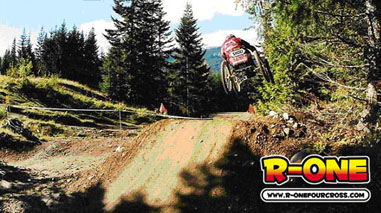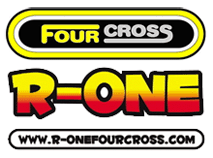
|
Canadian born Stacy Kohut, a leading light of the fourcross scene, talks exclusively to Rough Riderz about his life and his passion for the sport. An accomplished skateboarder, he also had a successful early career in BMX racing and motocross events. After a fall in 1992 left him paralysed he then went on to become the first Canadian to win a Gold Medal and World Championship Title racing in a sit-ski.
Now co-owner of R-ONE, with his business partner and team mate Johnny Therien, they spend their summers competing on the North American and Canadian downhill MTB circuits. Winter is spent building the R-ONE Fourcross bikes for a growing number of new enthusiasts.
So, here in his own words, the remarkable Stacy Kohut gives us a glimpse into his world�
 Where and why did fourcross racing start?
Where and why did fourcross racing start?
 The original incarnation of the sport goes all the way back to the late 1980�s, early �90�s. Heck, if ya wanna really go way back in the time machine, I am sure many people out there can remember the old days of riding or racing wagons, homemade go-karts, oversized children�s 'ride em� toys; the roots go waaaaay back. But goofing around on those things ain�t quite fourcross is it? The Cobra, a gravity fourwheeler, which was designed by the infamous John Castellano, was the first gravity machine that I ever saw that was the beginning of what we now call fourcross. This ride was piloted by the equally infamous John Davis, the ride and the athlete were totally dialled for the time and the Cobra/Davis combination was the benchmark for the sport for many years. Plain and simple, the combo kicked butt!!
The original incarnation of the sport goes all the way back to the late 1980�s, early �90�s. Heck, if ya wanna really go way back in the time machine, I am sure many people out there can remember the old days of riding or racing wagons, homemade go-karts, oversized children�s 'ride em� toys; the roots go waaaaay back. But goofing around on those things ain�t quite fourcross is it? The Cobra, a gravity fourwheeler, which was designed by the infamous John Castellano, was the first gravity machine that I ever saw that was the beginning of what we now call fourcross. This ride was piloted by the equally infamous John Davis, the ride and the athlete were totally dialled for the time and the Cobra/Davis combination was the benchmark for the sport for many years. Plain and simple, the combo kicked butt!!
Davis was a staunch supporter and promoter of complete integration with the 2 wheeled DH MTB race scene. Davis was out there racing the same courses, racing the same race series, had the same sponsors, was in the same magazines and generally fitting into the scene very seamlessly, he was living� it for sure. Castallano and Davis were able to lay the roots for the future, and they knew it. I was fortunate enough to be invited to stay with Davis and Castellano in the summer of 1999, Castellano had just finished his new ride, the ACE, and he and Davis decided it would be cool to get my butt in the Cobra for a weekend of riding and racing. During the span of that weekend, I really got a sense in watching Castellano ride the Cobra, and Davis setting up his new ride, that they knew they had started a sport that was going to be a sport for everyone to participate in, sitdown users and full abled-bodied alike. Davis has commented more than once, that this sport will evolve into something very unique.
Anyway, for me, that was the start, the vision had been laid out by the 2 pioneers. I had no problem not only seeing their vision, but wanted to be a part of the process also. Castellano and Davis were on it!
There were a few others coming on or had been on the scene around that time also, some being involved with the same type of vision as the Davis/Castellano combo, some others who had no idea what was going on with the evolution with the sport, they just wanted to ride. And then there were some that seemed to be involved for all the wrong reasons. Whatever, when you talk about the birth of the fully integrated sport of FOURCROSS, it starts and ends with John Davis and John Castellano. They are the reason why if ya ask me.
|
By the end of the 1999 summer, I had secured myself through outside industry sponsors, an amazing ride in the form of the DH-1. This ride was built and designed by Bill Grove, the man who had some killer cult-like success in the BMX world with the early high-class operation HUTCH. I trained my butt off during the fall, then picked it up again in the early spring 2000 to get ready for my first year doing battle with John Davis on the then world famous NORBA DH MTB circuit. I had sponsors to line up, training to do, and also many, many phone calls to Bill Grove to help with some development, as the DH-1 was beginning to show signs of limitations; I had no idea, but with my jumping and very aggressive riding style, I was definitely pushing the sport in a new direction. Bill and I became friends during this year; he was constantly amazed at what I was doing with his ride. I would e-mail him action shots, and he commented many times that the ride needed to be updated to reflect the new riding style I was developing.
 How did you and Johnny get involved in it and what got you both hooked?
How did you and Johnny get involved in it and what got you both hooked?
 I first met Johnny Therien at the Joyride DH Festival in 2000. It was slotted in nicely with the schedule for the season, and there was quite a few fourcross racers at the event. Johnny was the hometown guy that year, as I was living in Banff and had just come out for the event and to ride the park. It was obvious right from the start we had similar backgrounds, I am sure Johnny will say something else, maybe because we were racing each other that week, but I knew there was some common ground, whether it was skateboarding, music, outlook on life, whatever it was, I knew we had some similarities. We were both fully hooked on the sport individually when we met. He was hooked, I was hooked, we were riding and racing and we were loving the whole thing. I know from my perspective, I knew that this was THE sport that fit me. We raced that year, and then saw each other again the next summer in 2001, where we rode together, learned from each other, and just got to know each other. Bill Grove had quit by then, I had talked to him about the ride, and I know Johnny had also talked to Bill about the future of the sport and the ride. A few words were mentioned about it between me and Johnny, but not much.
I first met Johnny Therien at the Joyride DH Festival in 2000. It was slotted in nicely with the schedule for the season, and there was quite a few fourcross racers at the event. Johnny was the hometown guy that year, as I was living in Banff and had just come out for the event and to ride the park. It was obvious right from the start we had similar backgrounds, I am sure Johnny will say something else, maybe because we were racing each other that week, but I knew there was some common ground, whether it was skateboarding, music, outlook on life, whatever it was, I knew we had some similarities. We were both fully hooked on the sport individually when we met. He was hooked, I was hooked, we were riding and racing and we were loving the whole thing. I know from my perspective, I knew that this was THE sport that fit me. We raced that year, and then saw each other again the next summer in 2001, where we rode together, learned from each other, and just got to know each other. Bill Grove had quit by then, I had talked to him about the ride, and I know Johnny had also talked to Bill about the future of the sport and the ride. A few words were mentioned about it between me and Johnny, but not much.
I moved to Whistler in 2002, and when I got here in the spring, I went up to Johnny�s shop, and lo and behold he had sitting in front of him his first built fourcross mainframe. The guy can be so classic with that type of stuff, he knew I needed a new ride, he knew changes needed to be made to keep up to what both of us were doing, and wham-o, he just built one with the ultimate okay from Bill Grove himself. Very
|
The one thing we are really proud of, is that during the �dead years�(2002-2004), we were the only ones riding, racing, building, and selling fourcross rides. To this day, as of right now, we still are the only ones in the world selling fourcross rides. Our passion and persistence cannot be denied or ignored.
Its now going on 2008, R-ONE has made vast improvements and crucial modifications to take the durability and performance of our ride to our level of riding. If our bike passes the �R-ONE test�, if it passes the �Whistler Bike Park test�, then it�s good to go. Johnny�s ability to ride and build at a high level has definitely been a key part of the whole equation too.
We both got hooked because simply, fourcross is the most progressive and integrated sport out there. It just plain rips, we love fourcross, R-ONE loves fourcross.
 How established is the sport now and what race events currently include a fourcross class?
How established is the sport now and what race events currently include a fourcross class?
 The straight up answer is that there probably is not a single race organization group or series that would say �no� to a fourcross racer entering a race or event, provided they have the skill set appropriate for the race or event. Make sense? The sport is accepted, the riders all welcome. Integration is the key, seamless integration is the goal.
The straight up answer is that there probably is not a single race organization group or series that would say �no� to a fourcross racer entering a race or event, provided they have the skill set appropriate for the race or event. Make sense? The sport is accepted, the riders all welcome. Integration is the key, seamless integration is the goal.
 How many riders usually compete?
How many riders usually compete?
 I have seen 10 fourcross riders or more at certain events, both male and female, and on the other end of the scale, there have been many times I was the only one in a fourcross racing at the event, fully integrated into the male pro class. Both situations are healthy and needed for the sport of fourcross to grow. Also remember this, some owners of fourcrosses have no desire to race; they just ride and have fun with it, that�s cool too. I fully respect that.
I have seen 10 fourcross riders or more at certain events, both male and female, and on the other end of the scale, there have been many times I was the only one in a fourcross racing at the event, fully integrated into the male pro class. Both situations are healthy and needed for the sport of fourcross to grow. Also remember this, some owners of fourcrosses have no desire to race; they just ride and have fun with it, that�s cool too. I fully respect that.
 Where and how much time do you spend riding and training for your fourcross season?
Where and how much time do you spend riding and training for your fourcross season?
 I take time off during the winter months, we are usually building fourcrosses at that time anyway, but other than that, its full-on, 4 to 7 days a week, with all different degrees of intensity. I usually try to peak at the big events, and during other times such as video days etc, and will adjust my schedule accordingly. The norm is 4 days a week, 12 runs a day, very focused riding or race prep. Mental training plays a big part also and many hours a week are spent in this area. Hey, and don�t forget bike maintenance mixed into the week. You can spend over 40 hours a week on the sport of fourcross real fast. It�s my job. Like I said, it ramps up in days and intensity before an event, and I do have some rest periods during the 6 month season also, it is needed. It is quite intense, and I have great background in sport to draw from, and so I do draw from that background to make sure each season is progressive. I learnt a LOT about myself as a rider this summer, learning never stops. I really am trying to set the benchmark as high as possible, and keep that benchmark evolving and changing. Ride for fun. Race to win! It takes a lot of sacrifice to ride and race at the level I do, and I thank my sponsors and R-ONE for allowing me to push my limit. Johnny has been great in supporting my fanatical approach to riding. He has really met the benchmark level with the R-ONE Fourcross performance and durability. The fourcross I am currently riding has had the same mainframe going on its 4th year, it already has over 3.6 million vertical feet ridden on it, and still its fresh and ready to go.
I take time off during the winter months, we are usually building fourcrosses at that time anyway, but other than that, its full-on, 4 to 7 days a week, with all different degrees of intensity. I usually try to peak at the big events, and during other times such as video days etc, and will adjust my schedule accordingly. The norm is 4 days a week, 12 runs a day, very focused riding or race prep. Mental training plays a big part also and many hours a week are spent in this area. Hey, and don�t forget bike maintenance mixed into the week. You can spend over 40 hours a week on the sport of fourcross real fast. It�s my job. Like I said, it ramps up in days and intensity before an event, and I do have some rest periods during the 6 month season also, it is needed. It is quite intense, and I have great background in sport to draw from, and so I do draw from that background to make sure each season is progressive. I learnt a LOT about myself as a rider this summer, learning never stops. I really am trying to set the benchmark as high as possible, and keep that benchmark evolving and changing. Ride for fun. Race to win! It takes a lot of sacrifice to ride and race at the level I do, and I thank my sponsors and R-ONE for allowing me to push my limit. Johnny has been great in supporting my fanatical approach to riding. He has really met the benchmark level with the R-ONE Fourcross performance and durability. The fourcross I am currently riding has had the same mainframe going on its 4th year, it already has over 3.6 million vertical feet ridden on it, and still its fresh and ready to go.
 How long have you been competing?
How long have you been competing?
 I have been racing fourcross since 1999. I love everything about it, the bikes, the people, the scene, the full integration, the support from the mainstream media, everything man, everything!!! I stopped all other sports for fourcross, its so worth it, why bother with the rest when you have found the best! Fourcross is bad ass. Johnny has been at it, racing and riding since waaaay back in 1997.
I have been racing fourcross since 1999. I love everything about it, the bikes, the people, the scene, the full integration, the support from the mainstream media, everything man, everything!!! I stopped all other sports for fourcross, its so worth it, why bother with the rest when you have found the best! Fourcross is bad ass. Johnny has been at it, racing and riding since waaaay back in 1997.
 What is your most memorable fourcross race or moment to date?
What is your most memorable fourcross race or moment to date?
 There are so many memories over the past almost 9 years, some are race and ride related, some are related to the complete hilarity of travelling as a fourcross racer. Lets narrow this down to a race memorable moment, and to be honest, there a 2 of em.
There are so many memories over the past almost 9 years, some are race and ride related, some are related to the complete hilarity of travelling as a fourcross racer. Lets narrow this down to a race memorable moment, and to be honest, there a 2 of em.
The first race that really blew my mind was the 2000 NORBA Finals in Mammoth Mountain California. It was the season finale for my first full season of fourcross, and I was battling John Davis for the overall series title, it was close, it had come down to the last race, and I had beaten John for the first time in a downhill at the last stop of the NORBA series. He was ready, I was ready, and we both brought our full-on �A game�. The course was amazingly technical and very demanding. Small mistakes were not just gonna cost us seconds on the clock, they could ruin our rides and/or bodies even more.
There were many sections that John Davis and I could barely get through at a very slow pace during course inspection, let alone rip the section at race speed. There were times when I really didn�t want to do a section, and Davis would encourage me, then there were a few sections that I had to coax Davis into attacking. It was really weird, we were not gonna give an inch when we were course inspecting, so how was this race gonna play out? After that initial inspection, that was it, we did not ride together or do training runs together for the next 3 days, each one of us working on dialling in the course as best we could, and certainly not wanting to show each other our techniques and moves through some sections. Come race day it was insane, the lines we were ripping, the chances we were taking, the spectators/official�s jaws we were dropping. Shit was going down!
In the end Davis took the DH, and the series overall after I flipped the fourcross on the final turn coming into the finish line bowl area. I was so mad. Davis was the champ and well, he was so happy to have a good run himself while I crashed. That�s all a part of racing and in a small way I was happy for him. After it was over, in the pits Davis and I talked about how gnarly the race was. We both had sections where we were up on 2 side wheels, hands off the bars, grabbing trees, branches, roots, rocks or whatever it took to get through those simply insane sections. We laughed and were amazed at the fact we had just done something that 4 days earlier seemed impossible. The sections we had dialled from the start were attacked with amazing speed and risk, we both admitted to each other that we had pushed ourselves and our rides further and faster than we had gone before. This event and race had solidified my belief that fourcross can be one of the most demanding and dynamic gravity sports out there. I never looked at what I did, or what the others did in fourcross the same way again, it all seemed that much more valid and real after that week in Mammoth.
The second race that was memorable was the 2005 B.C. CUP race in Mission B.C. Johnny Therien and I were the only fourcross racers there, and we got ourselves into something we couldn�t back out of or quit, it just was not an option. We had shot our mouths off for months on how we were gonna race this course, no problem. We were racing. This race would be on a very flat course that was littered with uphills and sections that demanded you used your mind to problem solve sections that were completely nuts,� off camber uphill/downhill, one wheel on the ground, 3 in the air, 2 hands off the bars, one on the wheel, one on a slimy tree stump, pulling with everything you got, screaming and breathing at a crazy pitch and pace. Oh, and did I happen to mention that the practice times for Johnny and I were over 12 minutes long?
This course was beyond just a downhill; it was on the verge of being a lung bursting, arm pumping, endurance downhill for us fourcross racers. At race speed it was off the hook, controlling your breathing and your timing with certain power moves was crucial to getting through sections, let alone finishing the race. Ripping some sections at speed meant that by all accounts, we were risking our lives. By mid race I was tasting blood coming from my lungs, by � of the way down, I was hyperventilating and seeing black spots in certain sections.
|
 What do you feel are your biggest achievements in the sport so far?
What do you feel are your biggest achievements in the sport so far?
 You know, one of my biggest achievements I believe has been my ability to encourage newcomers and those with less high performance goals to feel welcome in the sport. This sport is not just about racing and being competitive; there is a whole other side that is about riding and expressing yourself in the fourcross on the trails and jumps.
You know, one of my biggest achievements I believe has been my ability to encourage newcomers and those with less high performance goals to feel welcome in the sport. This sport is not just about racing and being competitive; there is a whole other side that is about riding and expressing yourself in the fourcross on the trails and jumps.
That and being able to portray this sport in the mainstream media as a sport for everyone, integrated with the mainstream events and bike parks.
 How would you like to see the sport develop further in the future?
How would you like to see the sport develop further in the future?
|
 I and R-ONE believe that the sport�s future lies in integrated clubs, such as yours, as well as integrated rentals and lessons at the bike parks that are now everywhere on the planet. Of course we also believe that if someone wants nothing to do with clubs or races or the scene, they should be able to just buy a fourcross and go rip with their friends at the bike park. Freedom really. This sport�s future does not lie in being tagged an �adaptive sport�, the sport�s future is bigger than that, the athletes involved are more worldly than that, its all about fitting into existing programs and not segregating the sport. Also those that want to enter the sport and try to manipulate it for their own reasons and purposes should not be encouraged. The riders of fourcross bikes will develop the future, not men and women in suits, sitting in offices, telling us �how its is�. Lets not make the mistake many sports have made before, the writing is on the wall in some cases�.keep the wankers out!!!!
I and R-ONE believe that the sport�s future lies in integrated clubs, such as yours, as well as integrated rentals and lessons at the bike parks that are now everywhere on the planet. Of course we also believe that if someone wants nothing to do with clubs or races or the scene, they should be able to just buy a fourcross and go rip with their friends at the bike park. Freedom really. This sport�s future does not lie in being tagged an �adaptive sport�, the sport�s future is bigger than that, the athletes involved are more worldly than that, its all about fitting into existing programs and not segregating the sport. Also those that want to enter the sport and try to manipulate it for their own reasons and purposes should not be encouraged. The riders of fourcross bikes will develop the future, not men and women in suits, sitting in offices, telling us �how its is�. Lets not make the mistake many sports have made before, the writing is on the wall in some cases�.keep the wankers out!!!!
 What would you say to encourage more newcomers to try fourcross?
What would you say to encourage more newcomers to try fourcross?
 First of all, get somewhat fit. This sport, any sport, is easier to enjoy and participate in with a good general level of fitness. Realize that in a lot of ways, fourcross is a lifestyle, not a sport.
You just don�t try fourcross, you live it.
First of all, get somewhat fit. This sport, any sport, is easier to enjoy and participate in with a good general level of fitness. Realize that in a lot of ways, fourcross is a lifestyle, not a sport.
You just don�t try fourcross, you live it.
 What tips, tricks and advice can you give our new riders to help them improve their skills and ability?
What tips, tricks and advice can you give our new riders to help them improve their skills and ability?
 Again, get fit to start with. Take some lessons, if not with us at R-ONE here in Whistler, then take a lesson from your local bike park. The 2 wheeled instructor will have the basics of upper body positioning already dialled, the upper body is the same, setting up for corners is the same, braking is the same, that�s enough to work on for a while. Also, as you move through your progression, try to be as independent as possible, it makes for a strong body, mind, and spirit; which is very helpful in fourcross. And again, speaking of progression, have a plan for the fourcross season,
Again, get fit to start with. Take some lessons, if not with us at R-ONE here in Whistler, then take a lesson from your local bike park. The 2 wheeled instructor will have the basics of upper body positioning already dialled, the upper body is the same, setting up for corners is the same, braking is the same, that�s enough to work on for a while. Also, as you move through your progression, try to be as independent as possible, it makes for a strong body, mind, and spirit; which is very helpful in fourcross. And again, speaking of progression, have a plan for the fourcross season,
|
 How different is it to riding 2 wheels downhill?
How different is it to riding 2 wheels downhill?
 Not much really, it truly is an insane combination of MTB, BMX, MX, truck racing and supercross. A lot of similar actions and body positions for all the sports, fourcross just has some from each�.pretty cool if ya think about it really.
Not much really, it truly is an insane combination of MTB, BMX, MX, truck racing and supercross. A lot of similar actions and body positions for all the sports, fourcross just has some from each�.pretty cool if ya think about it really.
The main thing for beginners is that with riding a fourcross, you can not fall over, and that can be a very comforting thing for a lot of potential riders these days. Four wheels has much appeal to many people. Braaaaaaaaaaaaaaaap!!
 What are your main goals for the future of R-ONE and the fourcross scene now?
What are your main goals for the future of R-ONE and the fourcross scene now?
 Keep riding, keep selling, keep racing,� keep progressing as people, as riders, and as a company. R-ONE also wants people to know that if we go down a slope were the focus of the sport is the machine and not the athletes, we could be entering a situation were the riders could get marginalized and de-valued. It�s the riders that make the sport what it is, the fourcross technology will always play a part, but it�s the riders that are the real attraction. The riders will ultimately sell the sport with their passion and performances.
Keep riding, keep selling, keep racing,� keep progressing as people, as riders, and as a company. R-ONE also wants people to know that if we go down a slope were the focus of the sport is the machine and not the athletes, we could be entering a situation were the riders could get marginalized and de-valued. It�s the riders that make the sport what it is, the fourcross technology will always play a part, but it�s the riders that are the real attraction. The riders will ultimately sell the sport with their passion and performances.
 What other changes and/or improvements would you like to see?
What other changes and/or improvements would you like to see?
 There are so many potential riders out there right now sitting on the fence whether to buy a fourcross or not. I say �do it�, you will not regret it! You just need to follow your gut. So that�s really the only improvement fourcross needs right now, is more riders and some more racers. Other than that, there is no need to re-invent the wheel, or fight battles that do not exist, fourcross is moving ahead at a nice organic pace, nothing is being forced or faked. I like that. The other thing would be as the sport grows and some more manufactures become involved, is that everyone has some level of professionalism and respect for each other. No need to start slinging words and/or posting up crap and such stuff.
There are so many potential riders out there right now sitting on the fence whether to buy a fourcross or not. I say �do it�, you will not regret it! You just need to follow your gut. So that�s really the only improvement fourcross needs right now, is more riders and some more racers. Other than that, there is no need to re-invent the wheel, or fight battles that do not exist, fourcross is moving ahead at a nice organic pace, nothing is being forced or faked. I like that. The other thing would be as the sport grows and some more manufactures become involved, is that everyone has some level of professionalism and respect for each other. No need to start slinging words and/or posting up crap and such stuff.
Wanna finish with a big thanks to friends, sponsors, fans, family, R-ONE and you Phil. Can�t wait to ride with ya dude!!!
- That�s all folks! We just wanna give a big shout out to our fourcross friends, based in Whistler. A massive thank you to Mr Kohut and Mr Therien, aka R-ONE, for this great exclusive brought to you by the Rough Riderz crew!
Exclusive Interview by Phil Hall
(Club Secretary)
- For details on the R-One team, plus information on their products and services please click here to view their latest website news.
- To see some more photos of Johnny Therien in action please click here to view his gallery page.
- Or, click here to look at more great shots from Stacy Kohut�s fourcross gallery.

